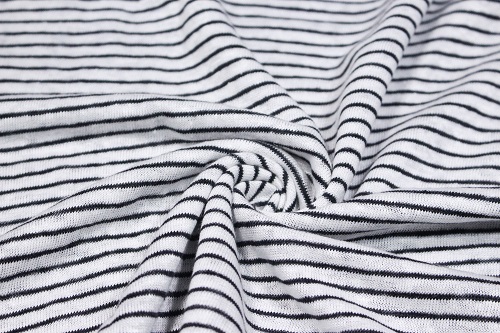0086-18057388688
Linen Jersey Knitted: The Modern Fusion of Tradition and Innovation in Textiles
Linen jersey knitted fabric represents the convergence of ancient natural fiber heritage and contemporary textile engineering. As the global demand for sustainable, breathable, and performance-oriented textiles rises, linen jersey knits have emerged as a preferred choice for both high-end fashion and functional apparel.
Origin and Material Composition of Linen
The Fiber Source
Linen originates from the Linum usitatissimum plant, commonly known as the flax plant. The fibers are extracted from the stem through retting, a controlled microbial process that separates the fiber bundles from the woody stalk. These bundles are further scutched, hackled, and combed to produce long, lustrous fibers suitable for spinning.
Fiber Morphology
Flax fibers are naturally bast fibers, characterized by:
- Length: 25–150 mm (depending on variety and processing)
- Diameter: 12–20 μm
- Cross-section: Polygonal with a central lumen
- Tenacity: 5.5–7.5 g/den
- Elongation at break: 2.7–3.5%
- Moisture regain: 12–14% at 65% RH
These parameters contribute to linen’s hallmark crispness, coolness, and high tensile strength.
From Woven to Knitted
Traditionally, linen has been predominantly used in woven constructions, prized for their stability and smooth surface. However, recent advances in knitting technology and fiber modification have enabled linen to be successfully incorporated into jersey knit structures — a transformation that has significantly broadened its textile applications.
Jersey Knitting Structure Overview
A jersey knit is a weft-knit fabric composed of intermeshing loops formed by a single set of needles. The loops in jersey fabric are aligned in vertical columns (wales) and horizontal rows (courses), giving it its distinctive stretch and flexibility.
The key parameters that define a jersey knit include:
- Gauge (G): Needles per inch (typically 18–28G for fine linen jerseys)
- Stitch density: Number of loops per unit area
- Course-to-wale ratio: Determines drape and dimensional stability
- Yarn twist and tension: Affects surface smoothness and elasticity
Yarn Engineering for Linen Jersey
Challenges in Knitting Linen
Pure linen fibers are low in elasticity, high in stiffness, and prone to breakage during high-speed knitting.
To mitigate these issues, textile engineers often:
- Blend linen with cotton, viscose, or elastane
- Employ wet spinning or compact spinning techniques to improve yarn cohesion
- Use soft twist yarns to enhance flexibility and reduce brittleness
- Apply pre-lubrication or paraffin waxing to lower friction between needles and yarn
Yarn Blends
Common blend ratios for linen jersey knits include:
- 100% Linen: Crisp hand feel, highly breathable, but low stretch
- 70% Linen / 30% Cotton: Improved softness and dimensional stability
- 60% Linen / 40% Viscose: Enhanced drape and sheen
- Linen / Elastane (98/2): Provides stretch recovery, ideal for fitted garments
Knitting Technology and Process Control
Machinery
Circular knitting machines are primarily used for jersey linen production. The single-jersey circular knitting machine with cam systems and latch needles enables fine control over stitch density and tension.
Key machine parameters:
- Cylinder diameter: 26–34 inches
- Feeders: 60–90 feeders for high productivity
- Speed: 18–25 RPM (reduced to prevent yarn breakage)
- Take-down tension: Optimized to prevent spirality or loop distortion
Process Adjustments for Linen
Since linen yarns are less elastic, adjustments include:
- Lower yarn tension: To avoid loop distortion
- Increased take-down pressure: To maintain uniform loop length
- Reduced machine speed: To minimize frictional heating and fiber breakage
- Humidity control: Maintain RH at 60–65% to enhance yarn pliability
Fabric Finishing and Post-Processing
After knitting, linen jersey fabrics undergo several finishing operations to improve handle, dimensional stability, and appearance:
- Scouring and Bleaching: Removes pectins, waxes, and natural coloration.
- Softening: Application of cationic or silicone-based softeners to enhance tactile comfort.
- Relaxation and Compaction: Helps minimize shrinkage and spirality.
- Enzyme or Bio-polishing: Gently removes protruding fibers for a cleaner surface.
- Tumbling and Washing: Imparts a vintage or “lived-in” look, enhancing drape.
For premium applications, mercerization or liquid ammonia treatment may also be used to increase luster and softness.
Physical and Mechanical Properties
| Property | Typical Range (Linen Jersey) | Comments |
| Fabric weight | 120–220 g/m² | Lightweight summer jerseys to midweight tops |
| Air permeability | 300–450 mm/s | Excellent breathability |
| Tensile strength | 280–350 N (warp), 150–250 N (weft) | Higher in wale direction |
| Dimensional stability | ±5% | After pre-compaction |
| Elastic recovery | 60–70% | Improves with elastane blending |
| Thermal conductivity | 0.040–0.050 W/mK | Naturally cool-hand feel |
| Moisture regain | 10–12% | Excellent moisture absorption |
| Pilling resistance | Moderate | Depends on blend and finishing |
Environmental and Sustainability Profile
Linen is widely recognized as one of the most sustainable natural fibers due to:
- Low water usage: Requires 80% less water than cotton.
- Minimal pesticide dependence: Naturally pest-resistant.
- Biodegradability: Fully compostable under natural conditions.
- Carbon sequestration: Flax plants absorb significant CO₂ during growth.
When produced in knitted form, linen’s sustainability further improves due to:
- Lower fabric waste (compared to woven cutting)
- Higher garment comfort, reducing overproduction of synthetics
However, sustainability challenges remain in bleaching and chemical finishing stages. Eco-friendly alternatives such as enzyme scouring, oxygen bleaching, and bio-based softeners are increasingly being adopted.
Applications and End-Use Sectors
Linen jersey knitted fabrics are used across a wide range of sectors:
- Apparel: Summer T-shirts, tops, dresses, sportswear, resortwear, and yoga garments.
- Home Textiles: Lightweight throws, pillow covers, and drapery.
- Technical Textiles: Eco-luxury interiors, automotive seat covers, and breathable composites.
- Medical and Wellness: Due to hypoallergenic and antimicrobial properties.
Premium brands increasingly use linen jersey for luxury loungewear and sustainable casualwear, leveraging its natural slub texture and matte sheen.
Emerging Innovations
Recent R&D has introduced several technological advancements:
- Stretchable linen jerseys using bicomponent yarns (linen-core with elastane sheath)
- Plasma surface treatment for enhanced dye uptake and reduced pilling
- Digital moisture mapping to optimize comfort performance
- Linen microblends with Tencel™ and bamboo for eco-luxury applications
Linen jersey knitted fabric stands as a remarkable example of how traditional natural fibers can be revitalized through modern textile innovation. Combining the breathability, luster, and sustainability of linen with the elasticity, softness, and flexibility of knitted structures, it bridges the gap between heritage and performance.
































